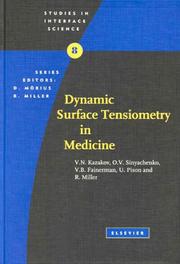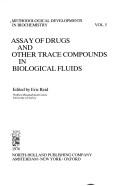| Listing 1 - 10 of 20 | << page >> |
Sort by
|

ISBN: 1280865679 9786610865673 4431471952 4431471928 Year: 2007 Publisher: Tokyo ; New York : Springer,
Abstract | Keywords | Export | Availability | Bookmark
 Loading...
Loading...Choose an application
- Reference Manager
- EndNote
- RefWorks (Direct export to RefWorks)
Decision making regarding fluid volume loading, fluid restriction, or administration of vasoactive drugs may vary among physicians, depending solely upon their clinical experience in the absence of evidence-based measurement. The initial distribution volume of glucose (IDVG) is believed to be clinically relevant as a marker of cardiovascular and fluid management in critically ill patients without a significant modification of glucose metabolism. This book covers all aspects of IDVG measurement, including the basic concept, its relationship with other fluid volumes, and the clinical application of this technique in the intensive care unit based on both the authors’ studies and their clinical experience with more than 4000 IDVG determinations. When the concept of IDVG is properly understood and its measurement is then performed routinely, daily fluid and cardiovascular management in critically ill patients can be improved based on evidence-based measurement.
Body fluids. --- Physiology. --- Animal physiology --- Animals --- Biology --- Anatomy --- Animal fluids and humors --- Body humors --- Fluids, Body --- Fluids and humors, Animal --- Humors, Body --- Physiology --- Critical care medicine. --- Anesthesiology. --- Intensive / Critical Care Medicine. --- Anaesthesiology --- Surgery --- Intensive care --- Intensive medicine --- Medicine --- Emergency medicine --- Intensive care units
Book
ISBN: 0815167032 0815167024 9780815167037 Year: 1974 Publisher: Chicago Year book medical publ.
Abstract | Keywords | Export | Availability | Bookmark
 Loading...
Loading...Choose an application
- Reference Manager
- EndNote
- RefWorks (Direct export to RefWorks)
Glandular physiology --- Body Fluids --- Kidney --- Kidneys --- physiology --- 612.46 --- physiology. --- Kidneys. Renal functions. Urine --- 612.46 Kidneys. Renal functions. Urine --- Body fluids --- Abdomen --- Urinary organs --- Nephrology --- Animal fluids and humors --- Body humors --- Fluids, Body --- Fluids and humors, Animal --- Humors, Body --- Body Fluids - physiology --- Kidney - physiology
Book
Abstract | Keywords | Export | Availability | Bookmark
 Loading...
Loading...Choose an application
- Reference Manager
- EndNote
- RefWorks (Direct export to RefWorks)
Animal fluids and humors --- Body fluids --- Body humors --- Fluids [Body ] --- Fluids and humors [Animal ] --- Fysiologie --- Fysiologie van de mens --- Human physiology --- Humors [Body ] --- Lichaamsvloeistoffen --- Liquides organiques --- Menselijke fysiologie --- Physiologie --- Physiologie humaine --- Physiology --- Vloeistoffen [Lichaams] --- 600.5 --- Weetjes --- fysiologie --- menselijk lichaam --- ook getest op mensen --- Menselijk lichaam; algemeen
Book
ISBN: 0429183275 1482223317 1000218961 1482223287 9781482223286 Year: 2016 Publisher: Boca Raton, FL : CRC Press,
Abstract | Keywords | Export | Availability | Bookmark
 Loading...
Loading...Choose an application
- Reference Manager
- EndNote
- RefWorks (Direct export to RefWorks)
Athletes and nonathletes frequently consume too little water or fluids, affecting exercise performance as well as overall health. This book comprehensively reviews the aspects relating to body fluid balance, rehydration, and physical exercise. It provides background on body water balance and turnover, topics related to electrolyte balance, and sweating as the basis for thermoregulatory and fluid homeostasis during exercise. In addition, chapters cover body water balance evaluation and regulation; cardiovascular and metabolic responses to fluid imbalance; effects of dehydration on aerobic power, muscle strength, and cognitive function; fluid intake timing; and optimal beverage selection.
Body fluids. --- Hydration. --- Dehydration (Physiology) --- Body water loss --- Water-electrolyte imbalances --- Animal fluids and humors --- Body humors --- Fluids, Body --- Fluids and humors, Animal --- Humors, Body --- Water-Electrolyte Imbalance. --- Athletic Performance. --- Water-Electrolyte Balance --- Athletic ability --- Troubles hydroélectrolytiques --- Sports, Aptitude pour les --- physiology.
Book
ISBN: 9783030515409 3030515400 3030515419 Year: 2020 Publisher: Basingstoke : Palgrave Macmillan,
Abstract | Keywords | Export | Availability | Bookmark
 Loading...
Loading...Choose an application
- Reference Manager
- EndNote
- RefWorks (Direct export to RefWorks)
This book explores the importance of bodily fluids to the development of medical knowledge in the eighteenth century. While the historiography has focused on the role of anatomy, this study shows that the chemical analyses of bodily fluids in the Dutch Republic radically altered perceptions of the body, propelling forwards a new system of medicine. It examines the new research methods and scientific instruments available at the turn of the eighteenth century that allowed for these developments, taken forward by Herman Boerhaave and his students. Each chapter focuses on a different bodily fluid – saliva, blood, urine, milk, sweat, semen – to investigate how doctors gained new insights into physiological processes through chemical experimentation on these bodily fluids. The book reveals how physicians moved from a humoral theory of medicine to new chemical and mechanical models for understanding the body in the early modern period. In doing so, it uncovers the lives and works of an important group of scientists which grew to become a European-wide community of physicians and chemists.
Médecine --- Medicine --- Body fluids --- Histoire --- Dix-huitième siècle. --- History --- Analysis --- Boerhaave, Herman, --- Intellectual life—History. --- Medicine—History. --- Europe—History. --- History. --- Intellectual Studies. --- History of Medicine. --- European History. --- History of Science. --- Annals --- Auxiliary sciences of history --- Health Workforce --- Animal fluids and humors --- Body humors --- Fluids, Body --- Fluids and humors, Animal --- Humors, Body --- Intellectual life --- Europe --- Science --- Intellectual History. --- Gay culture Europe --- Intellectual history

ISBN: 9780444504111 0444504117 9780080530598 0080530591 9786611038748 1281038741 Year: 2000 Publisher: Amsterdam ; New York : Elsevier,
Abstract | Keywords | Export | Availability | Bookmark
 Loading...
Loading...Choose an application
- Reference Manager
- EndNote
- RefWorks (Direct export to RefWorks)
Human biological liquids contain numerous low- and high-molecular weight surfactants. The human organism contains interfaces with enormous surfaces. The physicochemical and biochemical processes taking place at these interfaces are extremely important for the vital functions of the organism as a whole, and the interfacial properties may reflect peculiarities of age and sex, health and disease. The present book is the first attempt to systematically present the results of dynamic and equilibrium surface tensions measurements of serum and urine samples that were obtained from healthy humans of v
Semiology. Diagnosis. Symptomatology --- Surface tension. --- Body fluids. --- Physiology, Pathological. --- Physical biochemistry. --- Biophysical chemistry --- Biochemistry --- Physical organic chemistry --- Clinical physiology --- Pathological physiology --- Pathophysiology --- Physiopathology --- Pathology --- Physiology --- Animal fluids and humors --- Body humors --- Fluids, Body --- Fluids and humors, Animal --- Humors, Body --- Surface phenomena --- Capillarity --- Liquids --- Surface chemistry --- Surface energy --- Wetting
Periodical
ISSN: 15221466 1931857X Year: 1997 Publisher: Bethesda, Md. : American Physiological Society
Abstract | Keywords | Export | Availability | Bookmark
 Loading...
Loading...Choose an application
- Reference Manager
- EndNote
- RefWorks (Direct export to RefWorks)
Kidneys --- Body fluids --- Water-electrolyte balance (Physiology) --- Reins --- Liquides organiques --- Equilibre hydroélectrolytique (Physiologie) --- Periodicals --- Périodiques --- Kidney --- Équilibre hydroélectrolytique (Physiologie) --- Body fluids. --- Kidneys. --- physiology. --- Equilibre hydroélectrolytique (Physiologie) --- Périodiques --- APS-E EJMEDEC EPUB-ALPHA-A EPUB-PER-FT MDPHYSIO MDUROLOG --- Electrolyte-water balance (Physiology) --- Fluid-electrolyte balance (Physiology) --- Water balance (Physiology) --- Animal fluids and humors --- Body humors --- Fluids, Body --- Fluids and humors, Animal --- Humors, Body --- physiology --- Homeostasis --- Aquaporins --- Fluid therapy --- Osmoregulation --- Abdomen --- Urinary organs --- Nephrology --- Health Sciences --- Physiology --- Renal Replacement Therapy --- Ronyó. --- Fisiologia.

ISBN: 0582460107 0582460263 072040584X 0853121249 9780582460102 9780582460263 Year: 1976 Volume: v. 7 Publisher: Amsterdam North-Holland
Abstract | Keywords | Export | Availability | Bookmark
 Loading...
Loading...Choose an application
- Reference Manager
- EndNote
- RefWorks (Direct export to RefWorks)
Biochemistry --- Technique --- Body fluids --- Drugs --- Technique. --- Analysis. --- Body Fluids --- Trace Elements --- Liquides organiques --- 543.064 --- -Drugs --- -Medicaments --- Animal fluids and humors --- Body humors --- Fluids, Body --- Fluids and humors, Animal --- Humors, Body --- Analytical chemistry--?.064 --- -Analytical chemistry--?.064 --- 543.064 Analytical chemistry--?.064 --- Chimie clinique --- Pharmaceutical analysis --- Clinical chemistry --- Analysis --- Adulteration and analysis --- Analysis of pharmaceuticals --- Toxicology --- General biochemistry --- Pathological haematology --- Chemistry, Clinical. --- Pharmaceutical Preparations --- Médicaments --- analysis. --- Analyse --- Biochemistry - Technique
Book
ISBN: 1299400124 0124071996 0124071686 9780124071681 9781299400122 Year: 2013 Publisher: Oxford : Elsevier,
Abstract | Keywords | Export | Availability | Bookmark
 Loading...
Loading...Choose an application
- Reference Manager
- EndNote
- RefWorks (Direct export to RefWorks)
This original six chapter book will briefly review and integrate the basic concepts behind water distribution and movement in the body. This fills a knowledge gap that most medical and undergraduate physiology students acquire when these topics are studied separately. As of now, there is no textbook that fully integrates renal, cardiovascular and water physiology in a clear understandable manner. The book is intended primarily for medical students and undergraduate physiology students. Chapters include: 1) Water and its Distribution; 2) Water Dynamics; 3) Fluid Handling by the Heart and Blo
Human anatomy. --- Human physiology. --- Body fluids --- Cardiovascular system --- Urinary organs --- Circulatory and Respiratory Physiological Phenomena --- Anatomy --- Fluids and Secretions --- Phenomena and Processes --- Urogenital System --- Body Fluids --- Cardiovascular Physiological Phenomena --- Human Anatomy & Physiology --- Health & Biological Sciences --- Physiology --- Body fluids. --- Cardiovascular system. --- Urinary organs. --- Urinary tract --- Genitourinary organs --- Circulatory system --- Vascular system --- Blood --- Animal fluids and humors --- Body humors --- Fluids, Body --- Fluids and humors, Animal --- Humors, Body --- Circulation --- Water in the body. --- Blood water.
Book
ISBN: 0838589138 Year: 1983 Publisher: Norwalk Appleton-Century-Crofts
Abstract | Keywords | Export | Availability | Bookmark
 Loading...
Loading...Choose an application
- Reference Manager
- EndNote
- RefWorks (Direct export to RefWorks)
Body Fluids. --- Urinalysis. --- Body fluids --- -Urine --- -Pee --- Excretion --- Kidneys --- Animal fluids and humors --- Body humors --- Fluids, Body --- Fluids and humors, Animal --- Humors, Body --- Urinalyses --- Body Fluid --- Fluid, Body --- Analysis --- Examination --- Urine --- Analysis. --- Examination. --- -Analysis --- Body Fluids --- Urinalysis --- Casts, Kidney --- Diagnosis, Urinary --- Renal casts --- Urinary casts --- Urinary sediment --- Urine in disease --- Medical microscopy --- Clinical chemistry --- Pathology --- Semiology --- Tests --- Diseases --- Diagnosis --- Analysis and pathology --- Fermentation and ferments
| Listing 1 - 10 of 20 | << page >> |
Sort by
|

 Search
Search Feedback
Feedback About UniCat
About UniCat  Help
Help News
News